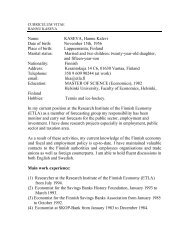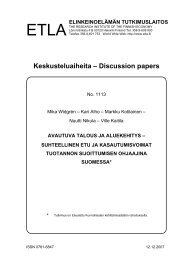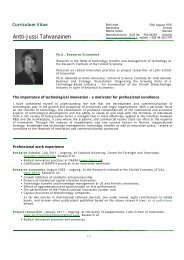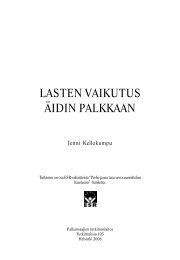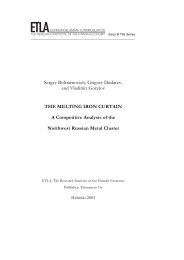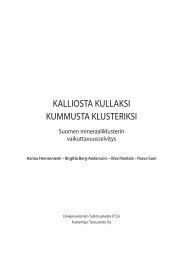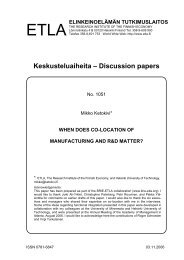Schooling, Family Background, and Adoption: Is it Nature or is ... - Etla
Schooling, Family Background, and Adoption: Is it Nature or is ... - Etla
Schooling, Family Background, and Adoption: Is it Nature or is ... - Etla
You also want an ePaper? Increase the reach of your titles
YUMPU automatically turns print PDFs into web optimized ePapers that Google loves.
If we repeat the analys<strong>is</strong> w<strong>it</strong>h 1992 income, parental IQ effects remain<br />
similar, <strong>and</strong> income effects become somewhat higher f<strong>or</strong> sons. Our nature<br />
estimates show that w<strong>it</strong>h respect to IQ transfers <strong>and</strong> educational outcomes<br />
44 percent <strong>is</strong> in the genes f<strong>or</strong> boys. Our 102 percent estimate f<strong>or</strong> girls shows<br />
that <strong>it</strong> <strong>is</strong> all genetics. W<strong>it</strong>h 1992 income that <strong>is</strong> generated by market luck<br />
we find that the nature component f<strong>or</strong> sons <strong>and</strong> daughters drop <strong>and</strong> become<br />
32 <strong>and</strong> 90 procent respectively.<br />
In the end, however, all likelihood ratio tests indicate that th<strong>is</strong> model<br />
<strong>and</strong> the model we estimate in Table 6 are stat<strong>is</strong>tically identical (cr<strong>it</strong>ical value<br />
<strong>is</strong> set at 14.1). Hence, in all four different specifications the estimates cannot<br />
reveal that boys <strong>and</strong> girls are affected differently by family background<br />
variables such as family income <strong>and</strong> parental IQ, <strong>or</strong> that the environment<br />
treats boys <strong>and</strong> girls differently.<br />
6 Selectiv<strong>it</strong>y, adopting families <strong>and</strong> adopted children<br />
While our nature <strong>and</strong> nurture estimates suggest that genes are rather dec<strong>is</strong>ive,<br />
we should treat our estimates w<strong>it</strong>h care. Since we do not observe<br />
abil<strong>it</strong>y of the natural parents of adopted children, the estimates may still<br />
suffer from abil<strong>it</strong>y bias. In fact, we are qu<strong>it</strong>e convinced that such a bias<br />
ex<strong>is</strong>ts. To determine sources of th<strong>is</strong> bias, <strong>it</strong> <strong>is</strong> instructive to return to our<br />
model once m<strong>or</strong>e. If e ∗ t−1 represents the parental abil<strong>it</strong>ies of biological parents<br />
of adopted children, the c<strong>or</strong>rected abil<strong>it</strong>y mobil<strong>it</strong>y relation <strong>is</strong> defined<br />
as<br />
e t = b 0 + (b 1 − b g1 δ t )e t−1 + b g1 δ t e ∗ t−1 + v t (6.1)<br />
which implies that the human cap<strong>it</strong>al function reads as<br />
h t = c 0 + b 0 c 2 + c 1 y t−1 +<br />
b 1 c 2 e t−1 − b g1 c 2 δ t e t−1 + b g1 c 2 δ t e ∗ t−1 + w t + c 2 v t (6.2)<br />
W<strong>it</strong>h th<strong>is</strong> in mind, we briefly outline some of the potential dangers of abil<strong>it</strong>y<br />
bias.<br />
• Selection in genes <strong>and</strong> adopted children.<br />
Children who are given up f<strong>or</strong> adoption are m<strong>or</strong>e likely to have less<br />
fav<strong>or</strong>able socio-economic backgrounds. The mechan<strong>is</strong>m to explain why<br />
18




